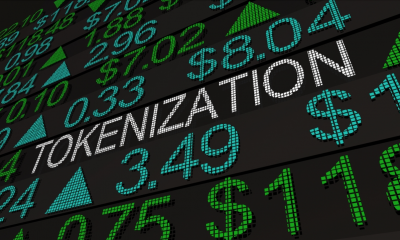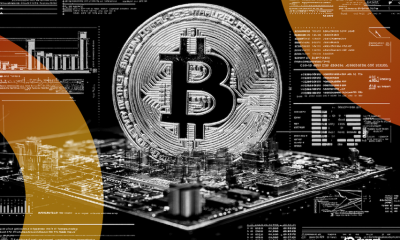

others
Mexican Peso slumps as Q1 GDP disappoints, US Dollar strengthens – Crypto News
- Mexican Peso falls over 0.41% after Mexico’s Q1 GDP growth underperforms expectations.
- Stronger-than-expected US Employment Cost Index bolsters US Dollar, diminishing prospect for imminent Fed rate cut.
- Despite quarterly GDP growth exceeding expectations in Mexico, annual figures fail to meet forecasts, contributing to Peso’s decline.
The Mexican Peso tumbles more than 0.41% against the US Dollar on Tuesday, following the release of Mexico’s Gross Domestic Product (GDP) figures missing estimates for the first quarter on a yearly basis.
That alongside with a reacceleration of inflation, according to data revealed in the United States (US), weighed on the Mexican currency. The Greenback has recovered some ground though. At the time of writing, the USD/MXN trades at 17.08 after hitting a low of 16.95.
Mexico’s National Statistics Agency (INEGI) revealed that GDP for Q1 2024 grew 1.6% YoY, a slower pace than the 2.4% in the last quarter of 2023 and beneath estimates of 2.1%. However, on a quarterly basis, the country grew 0.2% higher than the previous reading of 0.1% and exceeded the consensus of 0%.
Across the border, the US economic docket was busy, as the Employment Cost Index (ECI) a measure used by the Federal Reserve to assess inflation on wages was higher than expected, decreasing the odds of a rate cut by Fed Chairman Jerome Powell and Co.
Recent data witnessed Consumer Confidence deteriorating in the US, according to April’s data by the Conference Board.
This week, the US economic docket will be busy, though the most significant events will be the releases of the ISM Manufacturing PMI and the Fed’s monetary policy decision on May 1, followed by the Nonfarm Payroll figures on Friday and the ISM Services PMI.
Daily digest market movers: Mexican Peso tumbles on soft GDP, strong US inflation data
- Data revealed in April showed that Mexico’s inflation was mixed as headline inflation rose, mostly attributed to a jump in Oil prices. Contrarily, underlying prices dipped, justifying the Bank of Mexico’s (Banxico) decision to lower rates.
- Although most analysts estimate Banxico will hold rates unchanged at 11.00%, new data could open the door for heated discussions among Banxico’s Governing Council members on May 9.
- Last week, Banxico Governor Victoria Rodriguez Ceja said the central bank would be data-dependent. However, weak GDP data could pave way for a “live meeting” on May 9.
- Citibanamex Survey showed that most analysts expect Banxico to hold rates unchanged at the May meeting. The median foresees a rate cut in June, while they estimate the main reference rate to end the year at 10.00%, up from 9.63% previously.
- A broad gauge of US labor costs closely watched by the Federal Reserve accelerated in the first quarter by more than forecast, illustrating persistent wage pressure that is keeping inflation elevated.
- US Employment Cost Index (ECI), a measure of wages and benefits, rose by 1.2% QoQ after rising 0.9% at the end of 2023, exceeding forecasts of 1%, according to Bureau of Labor Statistics (BLS). That would keep the Fed on its holding pattern as fears of inflation reaccelerating loom.
- US Conference Board (CB) Consumer Confidence dropped in April from 103.1 to 97, its lowest level since mid-2022 as Americans’ view of the job market and the outlook for the economy deteriorated.
- Fed is expected to keep rates unchanged at May 1 meeting, though traders will be eyeing Fed Chair Jerome Powell’s press conference. A hawkish tilt could trigger a jump in favor of the Greenback; otherwise, the USD/MXN could resume its downtrend.
- Data from the Chicago Board of Trade (CBOT) suggests that traders expect the fed funds rate to finish 2024 at 5.080%, up from 5.035% on Monday.
MXN technical analysis: Mexican Peso trips lower as USD/MXN edges toward 200-day SMA
The Mexican Peso is making a U-turn, depreciating on Tuesday as the USD/MXN edges up. Even though the pair sits below the weekly high of 17.24, it is approaching quickly toward the 200-day Simple Moving Average (SMA) at 17.17. Once surpassed, the next stop would be the January 23 swing high of 17.38, followed by the year-to-date (YTD) high of 17.92, ahead of 18.00.
On the other hand, if USD/MXN buyers fail to conquer the 200-day SMA, further losses are seen beneath the 17.00 threshold. Once cleared, the next stop would be the 50-day SMA at 16.81 before challenging last year’s low of 16.62.
Banxico FAQs
The Bank of Mexico, also known as Banxico, is the country’s central bank. Its mission is to preserve the value of Mexico’s currency, the Mexican Peso (MXN), and to set the monetary policy. To this end, its main objective is to maintain low and stable inflation within target levels – at or close to its target of 3%, the midpoint in a tolerance band of between 2% and 4%.
The main tool of the Banxico to guide monetary policy is by setting interest rates. When inflation is above target, the bank will attempt to tame it by raising rates, making it more expensive for households and businesses to borrow money and thus cooling the economy. Higher interest rates are generally positive for the Mexican Peso (MXN) as they lead to higher yields, making the country a more attractive place for investors. On the contrary, lower interest rates tend to weaken MXN. The rate differential with the USD, or how the Banxico is expected to set interest rates compared with the US Federal Reserve (Fed), is a key factor.
Banxico meets eight times a year, and its monetary policy is greatly influenced by decisions of the US Federal Reserve (Fed). Therefore, the central bank’s decision-making committee usually gathers a week after the Fed. In doing so, Banxico reacts and sometimes anticipates monetary policy measures set by the Federal Reserve. For example, after the Covid-19 pandemic, before the Fed raised rates, Banxico did it first in an attempt to diminish the chances of a substantial depreciation of the Mexican Peso (MXN) and to prevent capital outflows that could destabilize the country.
-

 Cryptocurrency1 week ago
Cryptocurrency1 week agoJio Financial Services Share Price Surges Above ₹325, But Faces Hurdle at ₹347 – Crypto News
-

 Blockchain4 days ago
Blockchain4 days agoBitcoin Consolidation Continues: These Are Two Key Support Levels To Watch – Crypto News
-

 Blockchain1 week ago
Blockchain1 week agoWall Street Moves on-Chain Amid Tokenization of US Stocks – Crypto News
-

 Technology6 days ago
Technology6 days agoWho is Daniel Gross? Tech veteran who joins Meta as Zuckerberg deepens AI talent hunt – Crypto News
-

 Blockchain4 days ago
Blockchain4 days agoBitcoin Consolidation Continues: These Are Two Key Support Levels To Watch – Crypto News
-
others1 week ago
US SEC May Slash Crypto ETF Listing Time to Just 75 Days – Crypto News
-

 Cryptocurrency5 days ago
Cryptocurrency5 days agoTrent Share Price Crashes Over 9% After Weak Q1 Forecast, Nuvama Downgrade – Crypto News
-
Business4 days ago
Is Roger Ver the Satoshi Era Bitcoin Whale Behind $8 Billion BTC Transfer? – Crypto News
-

 Blockchain4 days ago
Blockchain4 days agoBitcoin Consolidation Continues: These Are Two Key Support Levels To Watch – Crypto News
-

 Blockchain4 days ago
Blockchain4 days agoBitcoin Consolidation Continues: These Are Two Key Support Levels To Watch – Crypto News
-

 Blockchain4 days ago
Blockchain4 days agoBitcoin Consolidation Continues: These Are Two Key Support Levels To Watch – Crypto News
-

 De-fi1 week ago
De-fi1 week agoDeFi-focused Layer 2 Katana Launches Mainnet With $200 Million in Pre-Deposits – Crypto News
-

 others1 week ago
others1 week agoWTI price bearish at European opening – Crypto News
-

 Cryptocurrency1 week ago
Cryptocurrency1 week agoKatana mainnet launch nears as pre-deposit closes with $200M in active deposits – Crypto News
-

 De-fi1 week ago
De-fi1 week agoBitcoin Firm BitMine’s Stock Surges Almost 700% on ETH Treasury Plan – Crypto News
-

 Technology1 week ago
Technology1 week agoTop 10 Lenovo laptops: Best all-rounders for work, gaming, browsing and entertainment – Crypto News
-

 Technology1 week ago
Technology1 week agoZuckerberg Debuts Meta ‘Superintelligence’ Group, More Hires – Crypto News
-
Technology1 week ago
What Is a Solana Staking ETF and How Does It Work? – Crypto News
-

 Cryptocurrency1 week ago
Cryptocurrency1 week agoMichael Saylor’s Strategy acquires $531M in Bitcoin, boosting holdings near 600,000 BTC – Crypto News
-
Business1 week ago
XRP Mid-Year Recap 2025: Major Events Until June and Upcoming Developments – Crypto News
-

 Blockchain1 week ago
Blockchain1 week agoBitcoin Holders Near Pain Point Last Seen In October 2024 – Crypto News
-

 Cryptocurrency1 week ago
Cryptocurrency1 week agoArbitrum jumps 5% on Robinhood news – But THIS can ruin ARB’s breakout – Crypto News
-

 Technology1 week ago
Technology1 week agoElon Musk’s X adds AI to its Community Notes, promises faster fact-checks with a human touch – Crypto News
-
Business1 week ago
XRP Price As Grayscale Gets Greenlight for ETF Launch, Including XRP – Crypto News
-
Business1 week ago
Why Is Crypto Market Up Today? – Crypto News
-

 Cryptocurrency1 week ago
Cryptocurrency1 week agoNio Stock Price Forecast for 2025, 2027, and 2030: Buy the Dip? – Crypto News
-

 Technology5 days ago
Technology5 days ago‘Notice the difference’: Elon Musk claims major upgrade to Grok chatbot’s question-answering abilities – Crypto News
-

 Cryptocurrency1 week ago
Cryptocurrency1 week agoBybit Partners With Backed to Bring Tokenised Stocks and ETF to Blockchain – Crypto News
-

 others1 week ago
others1 week agoBitcoin Increasingly Aligns With Store of Value Fundamentals – Crypto News
-
others1 week ago
Crypto Market Shaky as Elon Musk vs Donald Trump 2.0 Begins – Crypto News
-

 De-fi1 week ago
De-fi1 week agoPancakeSwap Launches v3 Liquidity Pools on Solana – Crypto News
-

 others1 week ago
others1 week agoWant to scrutinize how prices move after recent spike in price of rice moderates – Crypto News
-

 Cryptocurrency1 week ago
Cryptocurrency1 week agoThe new crypto debate: Monolithic distribution vs. modular tech – Crypto News
-

 Cryptocurrency1 week ago
Cryptocurrency1 week agoBinance Captures 94% Airdrop Market Share Driving User Engagement, Dominance – Crypto News
-

 others1 week ago
others1 week agoNexo Becomes First-Ever Digital Asset and Wealth Partner of the DP World Tour, Launches Nexo Golf Championship – Crypto News
-

 Cryptocurrency1 week ago
Cryptocurrency1 week agoCardano (ADA) Price Prediction for July 2 – Crypto News
-
Technology6 days ago
Turkey Bans Binance Chain DEX PancakeSwap Over Licensing Concerns – Crypto News
-
Technology6 days ago
JA Mining Redefines Crypto Income with Accessible Crypto Mining Platform – Crypto News
-

 Cryptocurrency4 days ago
Cryptocurrency4 days agoBinance stacks Ethereum at yearly high, U.S. funds buy more: So why isn’t ETH moving? – Crypto News
-

 De-fi4 days ago
De-fi4 days agoWorld Liberty Finance Opens Vote to List $WLFI Token – Crypto News
-

 Cryptocurrency1 week ago
Cryptocurrency1 week agoSolana Skyrockets as Bitcoin and Ethereum Grind Higher: Where Do Prices Go Next? – Crypto News
-

 De-fi1 week ago
De-fi1 week agoDeFi-focused Layer 2 Katana Launches Mainnet With $200 Million in Pre-Deposits – Crypto News
-

 Blockchain1 week ago
Blockchain1 week agoTradFi Could Eye Blockchain Due To Banking Frustration – Crypto News
-

 Cryptocurrency1 week ago
Cryptocurrency1 week agoAptos price surges as stablecoin supply nears all-time – Crypto News
-

 Blockchain1 week ago
Blockchain1 week agoSEC to expedite crypto ETF listing process? – Crypto News
-

 Cryptocurrency1 week ago
Cryptocurrency1 week agoFigma Eyes Further Bitcoin Exposure in Run-Up to Hopeful NYSE Debut – Crypto News
-
Technology1 week ago
Breaking: US Senate Passes Donald Trump’s ‘One Big Beautiful Bill’, BTC Price Reacts – Crypto News
-
Business1 week ago
Metaplanet Beats S&P 500 Q2 Revenue Estimates as Bitcoin Income Soars 42% – Crypto News
-

 Metaverse1 week ago
Metaverse1 week agoBaidu responds to Sora and other rivals with MuseSteamer and AI-enhanced search features – Crypto News
-

 Metaverse1 week ago
Metaverse1 week agoBaidu responds to Sora and other rivals with MuseSteamer and AI-enhanced search features – Crypto News












